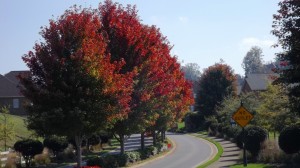Early leaf color or premature leaf drop often tells a property owner that their tree(s) may not be healthy. Photo above, taken in front of a new subdivision, says alot. Large red maples show leaf color weeks ahead of their natural timeline. Notice the narrow median where the trees are planted.
The cause of early foliage change may be weather-related, a foliar or root disease, an earlier insect infestation, or a site with one or more environmental factors. Extremes of either a dry or a wet summer (flooding) may lead to premature leaf drop or early fall leaf color. Urban air pollutants can be blamed.
In this landscape situation (photo), red maples were the wrong tree choice for the site. Red maple is nicknamed “swamp maple”; you find the species naturally growing along streams, and near lakes and ponds. Red maple has a notoriously shallow root system, a network of surface roots that destroy a home lawn or lift sidewalks.
In this example, on an obvious dry soil site, crape myrtle (Lagerstroemia spp.), sweetgum (Liquidambar styraciflua), elms (Ulmus spp.), Chanticleer pear (Pyrus calleryana), hornbeams (Carpinus spp.), or yellowwood (Cladrastis kentukea) would have been better tree choices.
A professional landscaper should have known that the tree choice was wrong. Unfortunately, mistakes like this are all too common.


 Posted in
Posted in 
